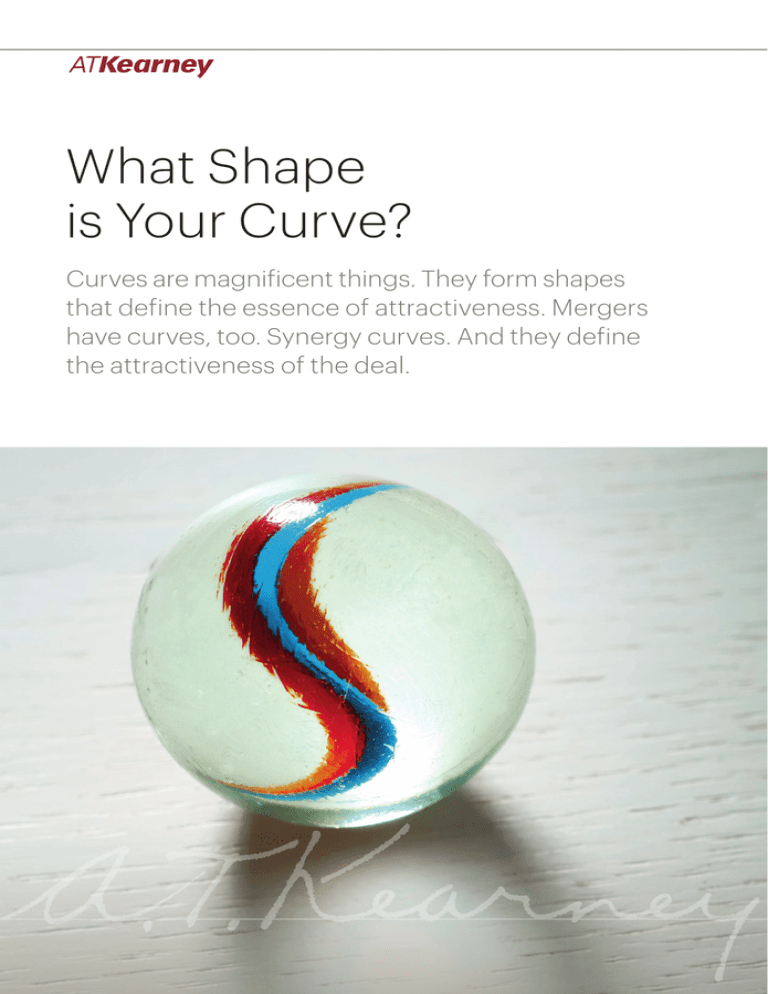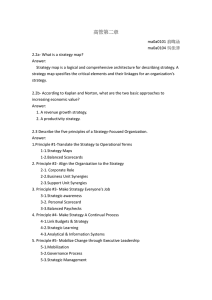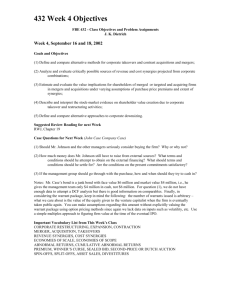
What Shape
is Your Curve?
Curves are magnificent things. They form shapes
that define the essence of attractiveness. Mergers
have curves, too. Synergy curves. And they define
the attractiveness of the deal.
What Shape is Your Curve?
1
Curves are magnificent things. Think of the Jaguar E-Type, the Sydney Opera House, or
a Coca-Cola bottle, all icons of our time. Mergers have curves too.1 Synergy curves. They reveal
the measure of attractiveness of the deal, either up front as part of a due diligence exercise
or when evaluating the deal’s ultimate success.
A synergy curve shows the accumulation of synergies over time, and it tells a thousand stories.
It is the result of months of preparation, planning, and implementation. Its shape is defined
by the integration strategy, the speed at which synergies are delivered, and the implementation
capabilities of the integration team and the broader organization. It stands as a testament
to the quality of the CEO’s vision and execution and will be scrutinized by the board, shareholders,
and markets. It ultimately defines the success or failure of a merger.
A synergy curve shows the
accumulation of synergies over time
and tells a thousand stories.
Plotting a curve helps clarify the deal’s strategic rationale, which is fundamental to maximizing
synergy delivery; once completed, it can be used throughout the integration to benchmark,
plan, and track the synergy delivery rate. So knowing the curve’s likely shape both helps validate
the rationale behind the merger and acts as a vital indicator as the integration progresses.
In this paper, we bring together our experience and data from many mergers to describe the
types of synergy curves for various integration strategies, and we highlight the typical time
frames for delivering synergies at an overall level and at the level of individual functional work
streams. Our experience-based examples provide a benchmark to compare integrations simply
by asking the question: What shape is your curve?
The Window of Opportunity
In every merger, there is a window of opportunity when newly merged companies can best
engage stakeholders to deliver synergies. During this time, there is a clear case for change,
intense top management attention, and significant committed resources. All stakeholders—
from suppliers and shareholders to employees and customers—are expecting change, and
it is important not to disappoint them (see figure 1 on page 3). After this window closes, the
outlook for delivering synergies is greatly diminished. A synergy curve, which represents the
time element of delivery, can provide valuable support to CEOs and other top executives as
they assess the merger’s synergy delivery.
Defining the Curve
Despite its importance, the curve is often plotted as an afterthought once the real work of
defining the synergies has been done. In successful mergers, it is defined in the early stages
and is used as a driving force for the integration.
For the purpose of this paper, the term merger is also used to mean acquisition.
1
What Shape is Your Curve?
2
Figure 1
Mergers have a window of opportunity to deliver synergies
Window of opportunity
Employees are
anticipating the merger
and are more open
to change
Shareholders are more
accepting within the
first year of investments
relating to the merger
Customers expect
immediate cohesion
of the joint sales forces
and seek better deals
Day 1 integration
checklist will be
prepared, including
protocols for
communications,
sales force,
operations, HR,
and so on
Day
100
By day 100,
announcement
synergies will
be identified and
approved, and
the budget
will be set
Year
2
By the end of
year 2, companies
will have achieved
their final-year
synergy run rate
Suppliers have settled
into working with the
new organization,
relationships have
changed, and expectations are for business
as usual
Shareholders have
decided whether the
merger has been
a success
Synergy buildup
Suppliers are looking
to grow sales with the
merged organization
and expect it to
leverage its increased
buying power
Day
1
Some employees
will have left the firm.
Others have new
priorities by year three
Time
Customers have made
their decisions on the
new organization’s
products and prices
Source: A.T. Kearney analysis
There are two ways to define the curve: Some companies track synergies as run rate savings;
others track the impact of earnings before interest and taxes (EBIT). The impact of EBIT is what
will appear in the financial results of the business and is often a point of discussion because CFOs
are more familiar with EBIT and use it for formal synergy reporting. However, we recommend
the method based on run rate, which is an implementation-focused metric. The full value of the
synergy benefit is recorded when it is delivered, giving CEOs a clear message about the pace
and progress of synergy delivery.
Figure 2 on page 4 shows a typical synergy curve.2 Modeled by taking an average of the curves
we developed for a variety of mergers, the y axis here represents the percentage of total
synergies to be delivered. For individual mergers, the y axis represents monetary value. The
x axis indicates the time elapsed from day one (the day the deal closes).3
On day one, an acquiring company typically plans to reach 1 to 2 percent of its final run rate,
for example through the normalization of supplier pricing differences identified in pre-close
clean-room analysis. By day 100, 2 to 5 percent of the final run rate should be reached, by rationalizing overlapping support functions and headquarters buildings, for example. By the end of the
second year, 92 to 97 percent of the full run rate can be reached by taking full advantage of the
merger’s window of opportunity, leaving as little as possible to be delivered in year three, when
the merger will seem like a distant memory.
Based on data from clients that have achieved their forecasts
2
Known outliers of the specific mergers have not been included.
3
What Shape is Your Curve?
3
Figure 2
Mergers can capture 97 percent of the full run rate by the second year
Percentage of total synergies to be delivered
100%
65 percent
of the full run rate
by month 12
90%
80%
90 to 97 percent
of the full run rate
by month 24
70%
60%
50%
40%
30%
100 percent
of the full run rate
by month 36
2 to 5
percent
of the full
run rate
by day 100
20%
Percentage of three-year run rate achieved
10%
0%
Quarter 1
Year 1
Year 2
Year 3
Time elapsed from day one
Source: A.T. Kearney analysis
How Does Your Curve Shape Up?
Synergy curves can be developed as early as the due diligence phase. Private equity buyers
in particular put a lot of effort into defining the importance and timing of potential synergies
during this early phase. Corporate buyers can also maximize the investment value by adopting
this discipline.
As the deal progresses through announcement and toward close, the curve’s accuracy can
be refined as more data is made available. Clean rooms, where an independent team stores
and reviews confidential data from both sides, can dramatically improve the curve’s accuracy
and ensure that execution of the synergy capture work streams can begin immediately after
close. Another tool for refining the curve is a “synergy summit” where functional representatives
from both sides can come together—even pre-close (and typically under legal supervision)—
to brainstorm potential synergies and determine the delivery time line.
These identified synergies are used to construct a partial synergy curve before day one and
the complete picture after day one. A final curve takes shape as the synergies are tested
through the development and sign-off of business cases in what A.T. Kearney calls the “acid
test” process. Although no curve is the same, the A.T. Kearney Synergy Curve can be used
to test synergy delivery plans, identify differences, and then refer back to the deal’s strategic
rationale to decide whether the synergy delivery remains true.
What Shape is Your Curve?
4
Where Do Synergies Come From?
Synergies can be related to either revenue or cost. Revenue synergies come from expanding
into new markets, exploiting new sales channels, and leveraging new products, innovations,
and brands. Cost synergies come from rationalizing support functions, optimizing operations
networks, and maximizing procurement leverage. Mergers typically generate both revenue and
cost synergies, but the balance of the two can dramatically change the character of the merger,
the integration strategy, and the ultimate shape of the synergy curve. Some companies refer
to acquisitions as being offensive or defensive. An offensive merger focuses on growth and
revenue; a defensive merger focuses on cost. In either case the integration approach and the
shape of the curve must be appropriate to the merger.
When growth is the main goal of a merger, cutting costs immediately after day one is unwise.
The synergy curve would look very different from a merger in which cost reduction is the primary
rationale for the deal. It is also important to develop a coherent story for the financial markets,
one where the deal rationale matches the synergy targets. The financial markets are typically
more receptive to a cost synergy story because it is more within the control of the acquiring
company and can be more easily evaluated. For example, plant closures or redundancy programs
can easily be linked to a merger, but revenue synergies are less directly linked and often need
to be played down to avoid raising anti-competition concerns.
In one recent example, overlapping geographies was the rationale for a merger. A strategy
was developed to exploit all growth opportunities stemming from the merger while still
achieving cost synergies. All synergies from sales opportunities were achieved by the end
of year two. A clean room process identified customer overlaps and opportunities so that
actions could be immediately taken on day one of the merger. Figure 3 shows the total synergy
curve for this merger, along with the curve for revenue and cost synergies. The ramp-up
Figure 3
One merger achieved all sales synergies by the end of the second year
Percentage of three-year run rate achieved
100%
90%
80%
Final run rate of sales
synergies achieved
by second year
70%
60%
50%
40%
Cost synergies
ramp up steeper
than revenue
synergies (general
and administrative
and procurement)
30%
Cost
20%
Revenue
Total synergies
10%
0%
Quarter 1
Year 1
Year 2
Time elapsed from day one
Year 3
Source: A.T. Kearney analysis
What Shape is Your Curve?
5
of overall synergy delivery in this example is less aggressive than in the A.T. Kearney Synergy
Curve shown in figure 2 for three reasons:
• Employee exits took more than six months from day one because of the required consultation
processes with works councils and unions.
• A transformation program was already in place, and a decision was made to near-shore to a
lower-cost country, which took longer to put in place.
• Some of the other activities that were not purely merger related depended on specific tools
being in place, which also took longer.
Pulling the Synergy Levers
Cost and revenue synergies are delivered at varying speeds. With a rigorously planned program,
savings are often achieved in a wave across procurement, operations, sales and marketing,
general and administrative (G&A), and R&D (see figure 4).
The quickest wins are usually in procurement and G&A. Procurement, often the first to achieve full
run rate, can provide immediate and consistent savings with price harmonization opportunities
identified either in the clean room or immediately after close. A second, more important wave
of procurement synergies can be delivered through volume leverage discussions with existing
suppliers and supplier rationalization. Further synergies—and the final tranche—will come from
a more complete strategic sourcing process, taking the combined business to a new group
of potential suppliers and optimizing the way each category is procured.
G&A synergies can be identified across the board, but the new headquarters decision should
be a priority for early savings.
Figure 4
Synergy savings often come in waves
Year 2
Year 1
Category
Q1
Q2
Q3
Q4
Q1
Year 3
Q2
Q3
Q4
Q1
Q2
Q3
Q4
Procurement
Operations
Sales and
marketing
General and
administrative
Research and
development
Source: A.T. Kearney analysis
What Shape is Your Curve?
6
In most situations sales synergies should be achieved quickly to win the best negotiating position
with customers and demonstrate to them the benefits of the merger. These are created by crossselling, aligning prices, and leveraging expanded offerings and go-to-market approaches.
A synergy curve stands as testament
to the quality of the CEO’s vision and
execution and will be scrutinized by
the board, shareholders, and markets.
Operations synergies typically take longer to deliver and can involve a mix of short-term
synergies driven by best-practice sharing and longer-term decisions that involve changes in
manufacturing strategy or supply chain consolidation. Major synergies can also be captured
by merging R&D functions. These often come later, after the innovation pipelines have been
evaluated and harmonized, and technical capabilities have been fully assessed.
Figure 5 shows the individual synergy curves for the different synergy types that underpin
the A.T. Kearney Synergy Curve.
Figure 5
The synergy curve will vary by category
Percentage of three-year run rate achieved
100%
90%
80%
70%
60%
50%
40%
Operations
General and administrative
30%
Procurement
20%
R&D
Sales and marketing
10%
0%
Quarter 1
Year 1
Year 2
Year 3
Time elapsed from day one
Note: Operations includes manufacturing rationalization and supply chain. General and administrative includes corporate, office rationalization,
and other. Procurement, R&D, and sales and marketing include revenue synergies and sales and marketing head count.
Source: A.T. Kearney analysis
What Shape is Your Curve?
7
Keeping Things Positive
Every merger will have negative synergies. It is the role of the merger team to identify these
quickly, proactively manage them, and reduce them where possible. These “dis-synergies” can
come from customers wanting to normalize trading terms and prices or not wanting to end
up in a sole source situation, or they can come from increased IT costs, particularly in a carveout situation.
If You Don’t Deliver Quickly, You Don’t Deliver at All
A merger with a sense of urgency, where synergies are delivered fast and furiously, is far more
likely to reach its full potential. In fact, “urgency” is one of the eight key success factors that
A.T. Kearney highlights to our merger integration clients. By plotting a synergy curve during
the planning of the merger, senior executives can see the speed at which synergies could be
delivered and, as the merger progresses, track the planned accumulation of synergies over time.
Used correctly, the synergy curve will be the fundamental tool for successful synergy delivery.
A synergy curve might not have the iconic status of the Jaguar E-Type or the Sydney Opera House,
but to the CEO, it will become the cornerstone of a successful merger.
Authors
Bob Haas, partner, New York
robert.haas@atkearney.com
Angus Hodgson, principal, London
angus.hodgson@atkearney.com
The authors wish to thank their colleague Amy Dullage for her valuable contributions to this paper.
What Shape is Your Curve?
8
A.T. Kearney is a global team of forward-thinking, collaborative partners that delivers
immediate, meaningful results and long-term transformative advantage to clients.
Since 1926, we have been trusted advisors on CEO-agenda issues to the world’s
leading organizations across all major industries and sectors. A.T. Kearney’s offices
are located in major business centers in 39 countries.
Americas
Atlanta
Calgary
Chicago
Dallas
Detroit
Houston
Mexico City
New York
San Francisco
São Paulo
Toronto
Washington, D.C.
Europe
Amsterdam
Berlin
Brussels
Bucharest
Budapest
Copenhagen
Düsseldorf
Frankfurt
Helsinki
Istanbul
Kiev
Lisbon
Ljubljana
London
Madrid
Milan
Moscow
Munich
Oslo
Paris
Prague
Rome
Stockholm
Stuttgart
Vienna
Warsaw
Zurich
Asia Pacific
Bangkok
Beijing
Hong Kong
Jakarta
Kuala Lumpur
Melbourne
Mumbai
New Delhi
Seoul
Shanghai
Singapore
Sydney
Tokyo
Middle East
and Africa
Abu Dhabi
Dubai
Johannesburg
Manama
Riyadh
For more information, permission to reprint or translate this work, and all other correspondence,
please email: insight@atkearney.com.
A.T. Kearney Korea LLC is a separate and
independent legal entity operating under
the A.T. Kearney name in Korea.
© 2013, A.T. Kearney, Inc. All rights reserved.
The signature of our namesake and founder, Andrew Thomas Kearney, on the cover of this
document represents our pledge to live the values he instilled in our firm and uphold his
commitment to ensuring “essential rightness” in all that we do.





